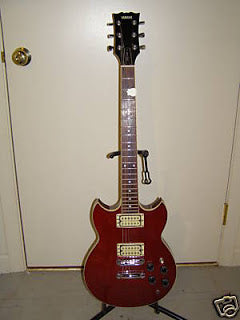Yamaha SBG500
Share
While the SG 30/35/50/70/90 and eventually 175 from the early to mid 70's held sway, Yamaha designer Yojirou Takabayashi and his staff went to work improving the guitar's design. The results were the SG-2000, SG-1500, SG-1000, SG-700 and SG-500, introduced to the world in July of '76, at the height of the "copy era" (typically, the model number is engraved on the truss rod cover).


Yamaha was definitely pursuing its own vision, so it's no wonder the SG-2000 was greeted so enthusiastically.
The SG-2000 employed the basic look of the SG-175, combined with both subtle refinements and some bolder new ideas. Instead of carved solid mahogany, the SG-2000 had a carved, mildly figured three-piece maple top, with the grain of the center section set perpendicular to the sides. Instead of a set neck, it featured a three-piece mahogany/maple/mahogany laminated neck-through design conducive to greater sustain. The body wings consisted of a "sandwich" of laminated mahogany.
In order to further enhance sustain, the SG-2000 had a brass block under the bridge.
Replacing the flat back of the SG-175 was a contoured back with a scoop out of the top waist to increase playing comfort. The head of the SG-2000 featured the now-standard double-dipped shape, with five-ply binding, a block lettering logo, and a fancy three-piece floral inlay. The 22-fret ebony fingerboard was bound with mother-of-pearl split-wing inlays. The top also featured five-ply binding.
In '79 or so Gibson began to object to Yamaha's use of the SG prefix. Gibson had already gone through the copy challenge of Ibanez in mid '77, so their objections may have even begun before that. In any case, in 1980 Yamaha changed the name of the guitar to the SBG-2000. The name was not changed in Japan.

The SG-1000, which was the second-in-line model in Japan, had some significant differences. From a distance it looked almost the same as the SG-2000 (including gold hardware), but with a bound rosewood fingerboard, "clay" split-wing inlays, and "only" triple binding. The top was a single piece of maple, without the perpendicular centerpiece, and was unbound. Instead of being a neck-through, it was set-neck with solid mahogany. Also, it did not have the brass sustain plate under the bridge.
The SG-1000 was equipped with slightly different electronics; the pots were wired such that when the volume pot was rolled up to 10, the tone control was bypassed - the equivalent of the slider switches on '60s guitars. These came in cherry sunburst or brown sunburst.
The SG-700 and SG-500 were almost identical to the SG-1000, but without the special wiring circuitry. These had slightly less fancy headstock inlays, dot inlays and chrome hardware. The SG-700 had an unbound maple top made of several pieces of maple and came in cherry sunburst and brown.
The 700 had traditional black plastic pickup covers with only one row of poles exposed. The SG-500 came only in opaque colors, black and cherry. Pickups on the 500 were exposed black or cream humbuckers. The SG-700 appears to have bit the dust with the SBG change in '78 or '79. The SG-500 likewise disappeared at this time, though it returned in '81 or '82 as the SBG-500.
